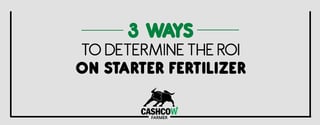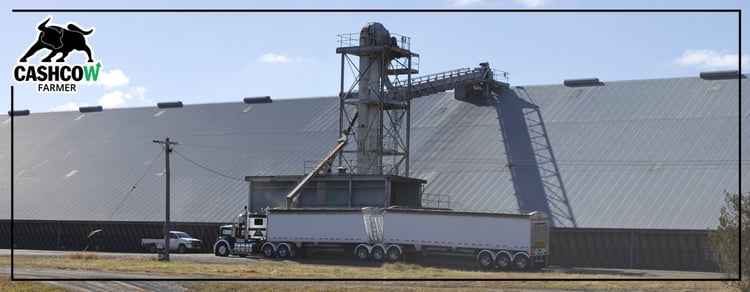
Spring is now yawning and waking up from its slumber, and most farmers are just about to start planting corn. Figuring out the return on investment for every input on your farm is crucial to making sure you’re the lowest-cost producer.
And since farming is somewhat of a competition, the lowest-cost producer wins.
Ready for some math? Today, we’ll focus on determining the ROI for one specific input: liquid starter fertilizer.
Does it make sense for your farm? Let’s see.
1) Break Down the Costs Into a Measurable Format
You have to break each cost down into something you can measure. Since farmers work in acres, we want to break down fertilizer cost into cost per acre. Then we’ll figure out how many bushels it will realistically take to pay for that cost and think about how many bushels we’ll get back.
For example: Let’s use the figure of $450 per ton for starter fertilizer. That’s weight: we buy it in weight and convert it to volume, meaning we need to find the density. The density is 11.65 pounds per gallon.
So dividing 2,000/11.65 tells us how many gallons are in a ton—about 172. Then divide $450 (the cost per ton) by 172 (the gallons per ton), which gives us $2.62 per gallon.
The last step is to multiply gallons per acre by the price per gallons. Most people put on around 5 gallons per acre, so we’ll multiply 5 x 2.63 = $13.01 per acre. Keep that number in mind. We’ll come back to it.
Lost yet? Check this out. Visualizing numbers usually helps!

2) Determine the Benefit of Using the Fertilizer
We’re not buying stuff just for fun: we want to get value out of it. So what’s the value of starter fertilizer on your farm?
If you look at studies, most people say you’ll get a 3% yield out of an investment in starter fertilizer. What 3% looks like is different for every field in your operation.
Let's say we expect a 3% increase in yield. On a 150-bushel cornfield, that’s 4.5 bushels per acre; on a 200-bushel cornfield, it's 6 bushels per acre. That’s our return rate. So we break that into the price.
You know how many bushels it is now, so the next step is to incorporate your cash price.
3) Break Even and Return
Let's say cash corn is 3.50 (though that value will obviously fluctuate with the market). Divide that into our cost: 13.01, remember? So 13.01/3.50=3.72.

A minimum of 3.72 yield increase is needed to pay for the fertilizer. If you’re not getting a four-bushel improvement, you’re not even paying for the investment. And to know you’re getting a four-bushel improvement, you’d have to first measure what you get without using that fertilizer.
The best way to do this, other than taking plot data, is to split-test your field. Plant half of it until you run out of fertilizer, then just keep going with your seed and don’t use any fertilizer. When you jump in the combine that fall, you’ll be able to see the difference in yield.
You should be split-testing a few different fields, based on your fields’ various soil types. Personalize these studies to make them fit your fields.
Back to the numbers. You only have to improve by 3.72 bushels—not bad, right? Let's start buying fertilizer.
But wait a second: we need to figure out the costs of logistics and equipment. Crap!
If putting liquid application on your planter is a $25,000 investment that will last for five years, that is part of the cost of that fertilizer, which can sometimes double the number. If you were planting 1,000 acres of corn with that fertilizer investments that would add another $5 per acre cost to the fertilizer, raising the total break even to $18.01. It might actually be closer to six or seven bushels you have to improve on to get a return.
Now these costs will vary dramatically, but if you take your annual fertilizer-specific equipment and logistics costs and divide them by how many gallons you will apply, then you can see the additional costs per acre and see how much yield improvement it will take to pay for them.
It’s simple to calculate just the return on fertilizer, but the logistics and equipment is a little more complex. There are all these hidden costs, and a lot of times farmers don’t think about that.
And obviously your rep’s not going to mention this!
Conclusion
When should you do these calculations?
Before you make the decision to lock in fertilizer price. As soon as you get the price quote on the fertilizer, you can go ahead and calculate the return on investment to see if it makes sense. In fact, anytime you get a price on anything, you can do this.
We’ve gotta do our homework as farmers and make sure our investments pay off. All of our investments need to produce for our farm. All of them. <Click to Tweet>
Or we should cut them out.
Want to know how to make every field profitable? Well, here ya go!




